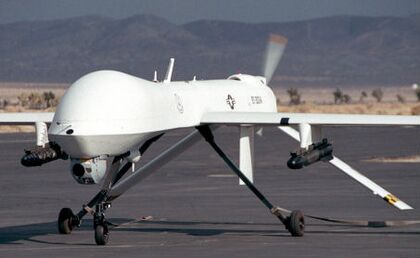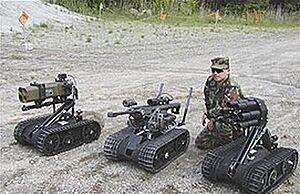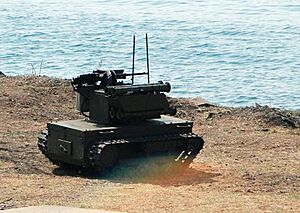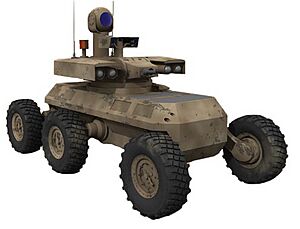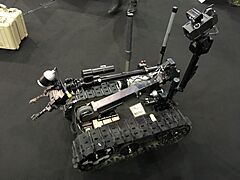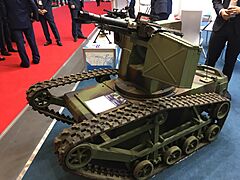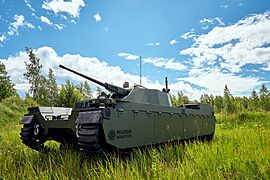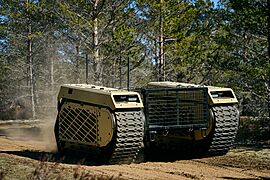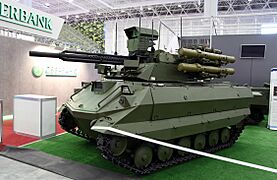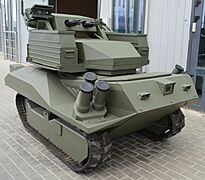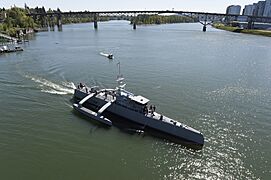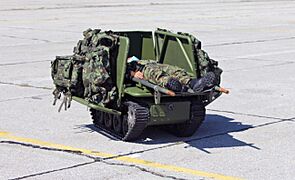Military robot facts for kids
Military robots are special machines used by armies. They can be controlled from far away or sometimes even make their own decisions. These robots help soldiers with many tasks, like carrying supplies, finding people, or even in combat. Many military robots are already in use, and new ones are being created all the time. Sometimes it's hard to tell the difference between a military robot and a military drone, but both are important tools for modern armies.
Contents
A Look Back: Robot History
Early Robot Ideas
The idea of military robots isn't new. Even during World War II, some early versions existed. For example, Germany used small, remote-controlled vehicles called Goliath mines. These were like tiny tanks that could carry explosives. The Soviet Union also had "teletanks," which were tanks controlled from a distance.
For a long time, robots in war were mostly just in science fiction stories. But as technology improved, real military robots started to appear.
Modern Robot Development
A big step forward came with the MQ-1 Predator drone. This was an aircraft that could fly without a pilot. It helped gather information and could even carry missiles. This showed how useful robots could be for armies.
Today, many countries are working on new military robots. The U.S. military has invested a lot in drones like the RQ-1 Predator. These drones can be controlled from far away and are used for scouting or even attacking targets.
Organizations like DARPA have held competitions to encourage companies and universities to build unmanned ground vehicles. These are robots that drive on land without a human inside. They learn to move through tough places like deserts.
Scientists are also looking into robots for artillery. One system, "Dragon Fire II," can load and aim a mortar very quickly. This helps soldiers respond faster. However, most military robots still need a human to make important decisions, especially when it comes to using weapons. This is to make sure they follow the laws of war.
There's also research into making fighter jets and bombers that can fly themselves. These robotic planes could do amazing maneuvers that human pilots can't. They also don't need life support, and if one is lost, no pilot is harmed. The main challenge is making them smart enough to handle unexpected situations. Artificial intelligence is helping with this.
In 2020, a Kargu 2 drone was reported to have attacked a target in Libya. This event raised questions about how much control robots should have in combat.
Robots in Action Today
Many types of military robots are used around the world right now. They help with different jobs, from scouting to carrying supplies.
- D9T Panda, Israel (a large armored bulldozer)
- Elbit Hermes 450, Israel (a drone for surveillance)
- Goalkeeper CIWS (a fast-firing gun system for ships)
- Guardium (an unmanned ground vehicle for patrols)
- IAIO Fotros, Iran (a large drone)
- PackBot (a robot for bomb disposal)
- MQ-9 Reaper (a drone for surveillance and attack)
- MQ-1 Predator (another well-known drone)
- TALON (a robot used for many tasks, including bomb disposal)
- Samsung SGR-A1 (a robot guard for borders)
- Shahed 129, Iran (a drone)
- Baykar Bayraktar TB2, Turkey (a popular drone)
- Albatross, Taiwan (a drone)
- Shomer Gvouloth ("Border Keeper"), Israel (a border patrol robot)
- THeMIS, Estonia (a versatile robot platform)
- The Sharp Claw and The Mule 200, used by the Chinese People's Liberation Army
- ARCV robotic mule, used by the Indian Army
Robots of Tomorrow
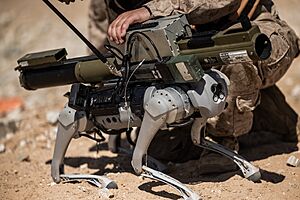
Scientists and engineers are always working on new and improved military robots. Here are some that are still being developed:
- MIDARS: This robot has cameras and radar. It can patrol military bases on its own. If it sees something unusual, it alerts a human operator. The operator can then take control or tell the robot what to do.
- Tactical Autonomous Combatant (TAC) units: These are ideas for future combat robots that could operate more independently.
- Autonomous Rotorcraft Sniper System: This is an experimental system. It's a sniper rifle attached to a helicopter that can fly itself. It's being tested for use in cities.
- The "Mobile Autonomous Robot Software" program: This project uses Segways to develop smarter robot software. The goal is to make robots that can think and act more on their own.
- ACER (a robot for engineering tasks)
- Atlas (robot) (a human-like robot for difficult terrain)
- Battlefield Extraction-Assist Robot (a robot to help move injured soldiers)
- Dassault nEUROn (a French UCAV, or combat drone)
- Dragon Runner (a small, tough robot for scouting)
- MATILDA (a robot for reconnaissance and bomb disposal)
- MULE (a US UGV for carrying supplies)
- R-Gator (a robotic vehicle for transport)
- Ripsaw MS1
- SUGV (a small robot for dangerous tasks)
- Syrano (a French robot for reconnaissance)
- iRobot Warrior (a versatile robot for various missions)
- PETMAN (a human-like robot for testing protective clothing)
- Excalibur unmanned aerial vehicle (a drone concept)
- Teng Yun (a reconnaissance drone from Taiwan)
How Robots Help Soldiers
Robots can be very helpful in military situations. One of the biggest benefits is that they can keep soldiers safer. By sending a robot into a dangerous area, human lives can be protected.
Lt. Gen. Richard Lynch of the U.S. Army said that robots can "improve the survivability of our service members." This means they help soldiers stay alive.
Major Kenneth Rose also pointed out that robots don't get tired or scared. They can stay focused for a long time, unlike humans who might get distracted. This makes them very reliable for tasks like standing guard.
Many military robots are controlled by humans and don't carry weapons. They are used for things like scouting, watching for danger, finding snipers, or safely dealing with bombs. Robots that do have weapons are usually controlled by a human operator. This means a human makes the final decision before a weapon is used.
Another advantage is that robots don't have emotions. This can help prevent mistakes that might happen if a human soldier is tired, stressed, or scared. Robots are designed to follow rules and laws of war, which can lead to more consistent and ethical actions on the battlefield.
The Big Questions: Robot Risks
Even though robots offer many benefits, there are also important questions and concerns about them. Some groups, like Human Rights Watch, are worried about "lethal autonomous weapons systems." These are robots that could choose targets and attack without a human making the final decision.
These groups are asking governments and the United Nations to create rules or even ban such weapons. They want to make sure that humans always remain in control of life-or-death decisions.
In 2015, many experts in artificial intelligence, including famous scientists like Stephen Hawking and Elon Musk, signed a letter. They asked for a ban on autonomous weapons, highlighting the serious risks if robots could decide to kill on their own.
Soldiers and Their Robot Friends
It might sound strange, but soldiers often form bonds with their military robots. They sometimes give the robots names, just like they would a pet or a friend. These names can be after family members or even celebrities.
Soldiers have even put fake medals on robots that survived tough battles. If a robot was destroyed, some soldiers felt sad and even held small funerals for them. A survey showed that many military personnel "liked" or "loved" their robots. This feeling was stronger for ground robots than for flying ones.
Going through dangerous situations together can make the bond between a soldier and a robot even stronger. As robots become more advanced with artificial intelligence, these connections might grow even deeper.
Robots in Movies and Games
Robots fighting in wars have been a popular topic in movies, TV shows, and video games for a long time. Many stories explore what it would be like if robots were a big part of future conflicts. If you're interested, you can find a list of these fictional military robots.
Images for kids
See also
- DARPA Grand Challenge
- Lethal autonomous weapon
- Human-in-the-loop
- Missile guidance
- Multi Autonomous Ground-robotic International Challenge
- Network-centric warfare
- Powered exoskeleton
- Roboethics
- Robot combat
- Robot Wars (disambiguation)
- Supersoldier
- Telerobotics
- Three Laws of Robotics
- Unmanned combat air vehicle
- US battlefield UAVs


